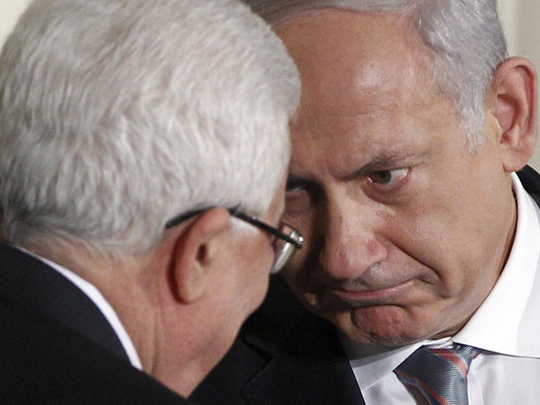
The Palestinian-Israeli direct talks scheduled in Washington are the long overdue final stages in the peace talks between the two sides. However, the resumption of the negotiations comes amid dwindling hopes that the talks will yield tangible results.
Pessimism is dominating statements of many officials, experts and analysts in the region.
The following is a time-line for the major events and meetings between the two sides in the last two decades.
October, 30 1991: The Madrid Peace Conference was hosted by the Spanish government and co-sponsored by the US and the Soviet Union. The three-day conference was an attempt by the international community to start the peace process through negotiations between Israel and the Palestinian in the aftermath of the Gulf War.
The framework of objectives was specified in the letter of invitation extended by US President George Bush, his Secretary of State James Baker and the Soviet Union. The letter was extended to Israel, Syria, Lebanon, Jordan and the Palestinians.
September, 1993: The Palestinians and the Israelis signed Declaration of Principles on autonomy after month of secret negotiations in Oslo, Norway. The importance of the Norwegian-auspices talks was that there was finally mutual recognition between Israel and the PLO. The historic agreement was signed on the White House lawn on September 13, 1993 and witnessed by US President Bill Clinton, when both Yasser Arafat and Yitzak Rabin shook hands.
The agreement was that Israeli troops would withdraw in stages from the West Bank and Gaza, that a “Palestinian Interim Self-Governing Authority” would be set up for a five-year transitional period, leading to a permanent settlement based on UN Resolutions 242 and 338.
The agreement spoke of putting “an end to decades of confrontation and conflict” and of each side recognising “their mutual legitimate and political rights”.
Therefore, though not stated explicitly in the text, the implication was that a state of Palestine would one day be set up alongside Israel. Hamas and other Palestinian projectionist groups did not accept Oslo and launched suicide bomb attacks on Israelis. There was opposition within Israel from colonists-led groups. The Oslo accord was only partially implemented.
May 4, 1994: Late Palestinian leader Yasser Arafat and Israeli Prime Minister Yitzhak Rabin signed an autonomy accord in Cairo.
October, 24, 1998: A new Palestinian-Israeli agreement was signed after 19 months of stalemate and animosity. It was signed by late Palestinian president Arafat and Israeli Prime Minister Benjamin Netanyahu on Maryland’s secluded Wye Plantation. The accord placed more of the West Bank under Palestinian supervision in return for security pledge.
July, 11-25, 2000: After various unsuccessful attempts made in Taba, Egypt, Wye River, USA and Sharm Al Shaikh to speed Israeli withdrawal and Palestinian self-government provisions of Oslo, former US President Bill Clinton decided to host another summit. At the summit, Clinton sought to address the final status issues — including border, Occupied Jerusalem and refugees.
Clinton hosted both Arafat and former Israeli Prime Minister Ehud Barak at Camp David. However, the talks ended in failure over the issues of Occupied Jerusalem and Palestinian refugees.
March, 2002: After the failure of bilateral talks and the resumption of conflict, Saudi Arabia presented a peace plan to the Arab Summit held in Beirut in March 2002. It signalled the desire of the Arab world to put an end to the centuries old dispute.
Under the plan, Israel would withdraw to the lines of June 1967, a Palestinian state would be set up in the West Bank and Gaza and there would be a “just solution” of the refugee issue. In return, Arab countries would recognise Israel. The plan re-endorsed once again in the Arab summit held in Riyadh, Saudi Arabia, in 2007.
In June 2002, George W Bush became the first US president to call for a Palestinian state.
June, 4: 2003: “Roadmap” for the creation of a Palestinian state by 2005 launched by US President George W. Bush, Israeli Prime Minister Ariel Sharon and Palestinian Prime Minister Mahmoud Abbas in Aqaba, Jordan.
February 2, 2005: Sharon and Abbas, who became the president of Palestinian National Authority meet in Sharm Al Shaikh and declared an end to hostilities.
November 27, 2007: Abbas and Israeli prime minister Ehud Olmert formally restart negotiations at Annapolis, Maryland.
December 27, 2008: Israel begins a devastating 22-day military offensive in the Gaza Strip, prompting the Palestinians to suspend talks.
May 9, 2010: Indirect talks start between Israelis and Palestinians
August, 20, 2010: US Secretary of State Hillary Clinton invites Israel and the Palestinians to resume direct negotiations in Washington on September 2.












